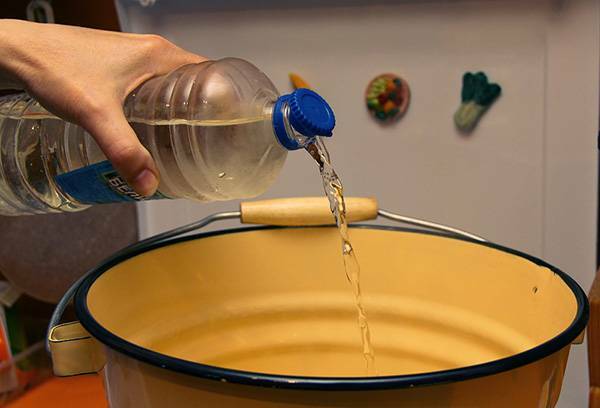
- How to wash dishes using a dishwasher - the five rules of the
- What can not be cleaned with a dishwasher?
For sure, every owner of the dishwasher faced such a question that it is possible and what can not be washed in the dishwasher, because the purity and integrity of the dishes depend on this. We will help you to solve this problem, and also give you some useful tips.
to the contents ↑How to wash dishes using a dishwasher - the five rules of the
So that you do not have any problems with the process itself or with the cleanliness of kitchen utensils after its treatment in washing equipment, adhere to such rules.
The first rule is the correct placement of dishes inside the
machine. It has already become normal that two dishwasher baskets are built in modern dishwashers. Proceeding from such a device, it's easy to understand what can and can not be washed in a dishwasher. Here the rules are as follows:
- The basket, which is located below, is intended for large kitchen items, such as: pots, large dishes, pans.
- Top - for tableware, such as: plates, cups and much more.
Important! Spoons, forks, knives, as well as other cutlery, are usually placed in a special small basket or a tray that goes to the component of the dishwasher or sold separately.
In order to optimally place the dishes inside the machine:
- Start the load from the bottom basket.
- Place huge plates in the outermost corners, small ones - place them closer to the center. In the middle, put the basket or the tray with cutlery.
- If there is no tray, then put forks and spoons in the center, just for the rest of the dishes.
- The dishes should not interfere with the rotation of the rocker arms of the machine. That's why, do not put items with long handles, such as pans and other, vertically.
- In a dishwasher, water is usually fed from the bottom up, and that's why put hollow objects such as: mugs, plates, cups upside down.
- Do not put them on their side, because they will have water and not washed away with detergent.
- Do not place table objects in each other.

Important! Do not overload the machine. If the dishes are extremely dirty, then the best option is to put the plates not in all the cells of the basket, but through one.
Rule two - choose the correct mode
The standard process of the dishwasher operation includes:
- preliminary cleaning, that is washing off food residues with cold water;
- directly wash with hot water and detergent;
- rinsing;
- washing-off and drying.
Important! The program you selected, and this time and temperature of washing, must necessarily correspond to the type of dishes and the degree of contamination.
In addition, in the dishwasher sometimes there are programs such as:
- intensive washing, that is, at a very high temperature - up to 70 degrees;
- program for not strong dishes, in which the water temperature is from 35 to 45 degrees;
- quick washing - when you need to quickly rinse the dishes immediately after eating or after fatty foods.
All these additional options become very relevant if you are asking yourself which dishes can not be washed in the dishwasher and whether it is possible to wash the crystal in the dishwasher.
Important! In addition, in the dishwashers of medium and high quality grade there is a function of pre-soaking. But it will be much easier and more economical if before you load the plates into the machine, you clean off the leftover food rests from them with your hands. Also do the same with burnt pots or frying pans.
Rule three - use detergents correctly
Only special detergents are used in dishwashers.
Do not use ordinary gels, as well as dishwashing powders - they give too much foam, because of which the technique can completely fail.
Detergents that are used in dishwashers can be divided into 2 types - powdered, as well as tableted.
Powders
The most common are powders. On average, the consumption of such a product for 1 cycle of work of the dishwasher is approximately 25-30 g.
Tablets
Tablets are considered more convenient. They are single-layered, multi-layered, and also combined.
The latter is considered to be the most practical, because they combine both detergent components, rinse aid, and regenerating salt. If the model of your dishwasher provides for the use of such substances, you will not have to purchase three different means.
Important! Nevertheless, please note that the feedback of many users with this technique and means proves the opposite effect. The more a manufacturer includes functions in one tool, the less it gives a result for each important parameter.
Application features:
- The consumption of tablets is approximately 1 tablet per 1 working cycle.
- It is not recommended to use tablet detergents combining them with gentle washing programs, because the tablet does not have time to dissolve properly.
Properties of detergents
According to their properties, dishwashing detergents are divided into strongly alkaline, as well as slightly alkaline detergents, as a rule, they contain enzymes.
Enzymes are enzymatic additives of biological origin that break down proteins, polysaccharides and fats that make up contaminants. Detergents with enzymes, as a rule, are used to wash fragile dishes.
Important! More is not purer. Use the amount of detergent specified in the instructions. In addition, if the package does not contain special instructions, do not use it to wash fragile or silver dishes .
Auxiliary tools
In addition to the basic detergent-cleaning agent, for more efficient use of the dishwasher, you need to buy a rinse aid. It:
- liquidates the detergent residue;
- gives the dishes a shine;
- promotes its rapid drying.
Important! The rinse aid consumption is approximately 0.6-0.8 l for 11-13 operating cycles.
Rule four - watch the water hardness level
Clean your dishes that are washed in the dishwasher, also depends on the hardness of the water. It is because of the hard water, and not because you did not decide on time that you can not wash in a dishwasher, white stains often remain on kitchen objects.
To achieve water softening, use regenerating salt. The capacity for it in cars is quite large - by 1.5-2 kg. This volume suffices for a long time.
Important! Lime from hard water can settle on the heating parts of the machine, which leads to a breakdown of the machine. Therefore, salt is also necessary for the preservation of the device.
The fifth rule is to look after your dishwasher
Absolutely any technique likes to be looked after. Dishwashers are no exception. In order for your machine to serve you faithfully and faithfully for many years, follow these tips:
- Clean the filter from time to time, on which the washed away remains of food settle.
- Clean the dish baskets regularly - they are easily removed.
- Use additional tools to better care for your dishwasher.

Important! It is recommended to use a degreaser in the form of a powder or gel-like substance every 15-20 operating cycles. It helps to eliminate accumulated fat from the internal parts of the machine.
to the contents ↑What can not be washed with a dishwasher?
Traditional washing method, with dishwashing detergent, brush and sponge, so far no one has canceled! And some dishes still have to apply the method of manual processing, so as not to spoil it.
So, what utensils can not be washed in the dishwasher:
- Cast iron, enamel, and copper utensils must never be washed in a dishwasher: cast iron - will be covered with rust, enamel - cracked, and copper utensils may lose shape.
- Dishes with decor, as well as fine finish, eventually gets worn and worn out.
- Wooden spoons and other wood products will spoil, scratch or crack. If you do not mind to change often, you can wash them with all the other dishes in the car.
- Qualitative and good knives are quite expensive, that's why do not take risks.
- Crystal, especially thin. Remains of food can scratch it, and from high temperatures can appear small cracks.
- If you are thinking about whether it is possible to wash aluminum dishes in a dishwasher, the answer is unambiguous - you can not. Old items will be strongly oxidized under the influence of alkaline and acidic substances that make up the detergents. Over time, they can be formed from such processing holes. A newer, anodized dish, this approach is also unacceptable. The utensil from such metal loses its shine and visibly becomes turbid.
Important! To make washing the dishes safe - both for kitchen utensils and for household appliances, additionally follow these rules:
- Tools after washing should be wiped - so that they are not covered with rust.
- Remove any hair and similar debris from the brushes to prevent blockage.
Features of dishwashing glass
Modern dishes made of strong and reliable glass are excellent for cleaning in a dishwasher. But you need to carefully and correctly place it inside the machine. Here it is necessary to take into account such features of the material:
- Objects that are too close to each other can, during the vibration of the machine, fight against each other. This will automatically lead to the appearance of cracks and chips, which will shorten the shelf life of the dishes.
- If the glass is thin, you need to use special programs for gentle washing, which guarantees a more delicate approach to objects.
- During installation of the dishwasher in a dishwasher, it is necessary to use clips, as well as levers for fixing. This will help protect your subjects from bumps, as well as from falling.
Features of washing porcelain items
Both faience and porcelain are perfectly washed in a dishwasher. However, there are no special requirements for the temperature regime and the use of any special means.
Useful advices are as follows:
- If the dishes have gilding, it is better to wash it not with boiling water, but with warm water, using a gentle mode.
- The same is true for cup saucers, which have a pattern on top of the glaze.
- If the pattern is under the surface of the glaze, then it is not terrible to tarnish.
Features of plastic washing:
- In the dishwasher can not wash any plastic or plastic kitchen appliance, but only heat-resistant.
- Such products are very light and need to be clamped. Otherwise - the dishes will walk inside the machine while washing. So - it can break or it will be badly washed, and there will be a lot of extraneous sounds.
We hope that our tips will help you to preserve your cutlery in integrity and safety, and also to protect your dishwasher from unwanted premature breakage.



